Frizzle chickens have recently been capturing the hearts of chicken keepers and poultry enthusiasts around the world.
With their unique appearance and friendly nature, these beautiful birds have become increasingly popular among both hobbyists and chicken enthusiasts.
In this article, we will discuss:
- What frizzle chickens are
- Frizzle chicken origin and history
- Their physical characteristics and appearance
- Reasons why they make excellent additions to any backyard flock
- Frizzle chicken care
- And some frequently asked questions
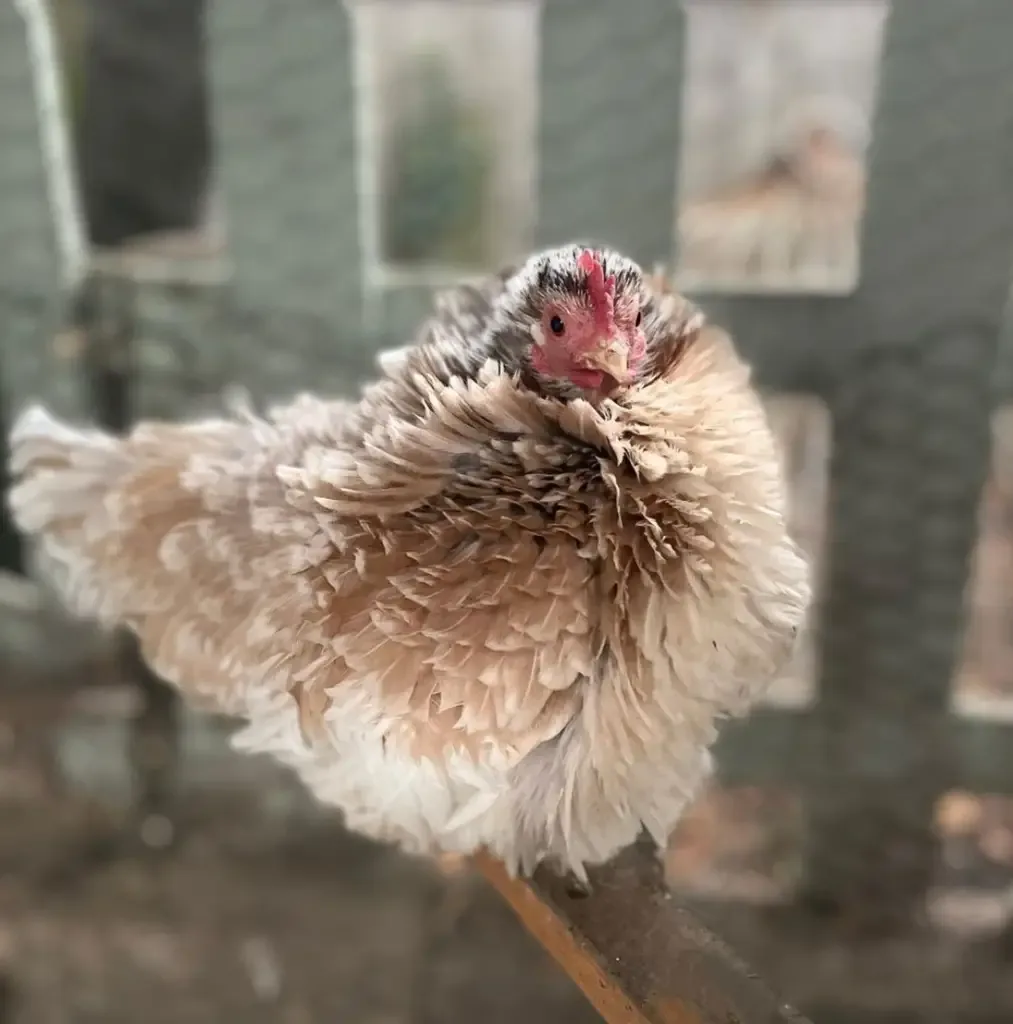
Frizzle Chickens Origins & History
Frizzle chickens have an intriguing history that dates back centuries.
The exact origins of frizzle chickens are unknown, but it is believed that they originated in Asia.
Charles Darwin even mentioned them in his documents, referring to them as “Caffie Fowl.” It is thought that the frizzle gene may have originated in India, but this has not been confirmed.
Then these birds were known to make their way to Europe during the mid-19th century.
Frizzles were first mentioned in historical documents in the 1600s, and they were likely bred for their unique appearance.
The frizzle gene causes the feathers to curl outward instead of lying flat against the bird’s body, giving frizzles their distinctive look.
They quickly gained attention due to these distinctive curly feathers, which set them apart from other chicken breeds.
Today, frizzles can be found in various countries, each with its unique breed standards and characteristics.
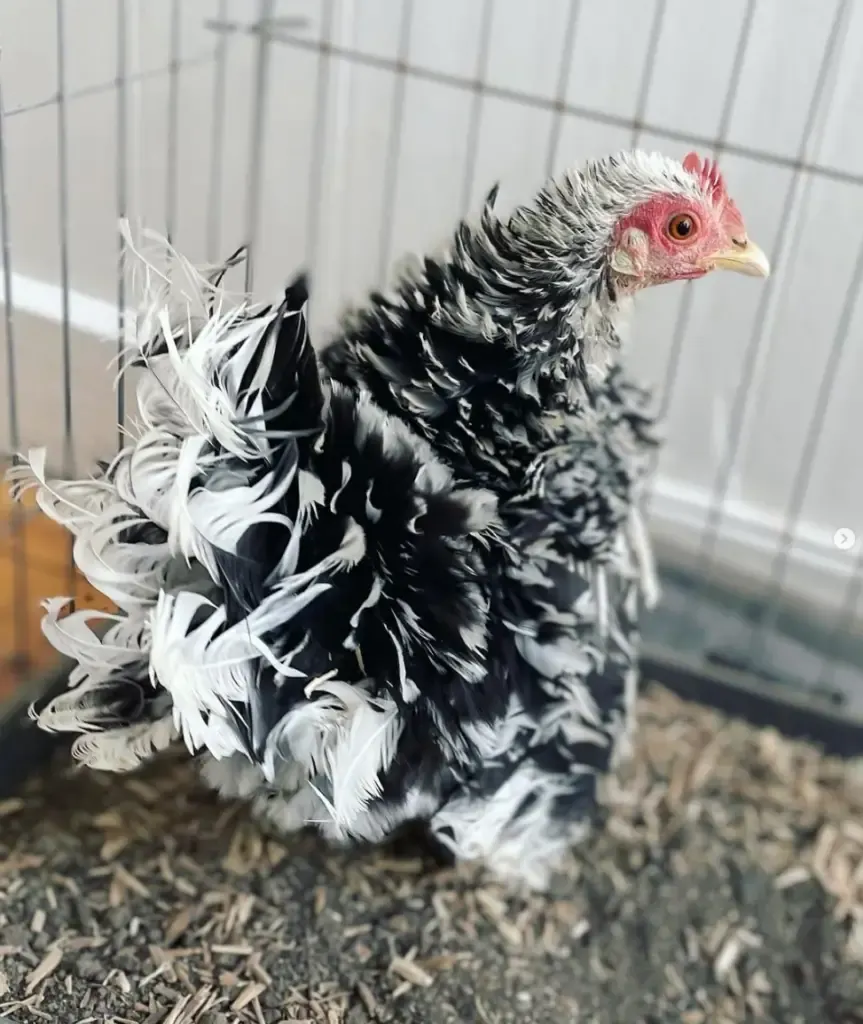
What is a Frizzle Chicken?
The hallmark feature of frizzle chickens is their unique feather structure.
Frizzle chickens are not a unique breed, but rather a group of existing breeds with a unique feather variant.
Unlike regular chickens, frizzles have feathers that curve outward instead of lying flat against their bodies.
This gives them a fluffy, ruffled appearance that is undeniably charming.
The Frizzle part comes from them having an incomplete dominant gene (F), which causes the feathers to curl outwards and make the chicken appear fluffy.
The most common frizzle breeds include:
- Cochins
- Polish
- Barred Rocks
- Japanese Bantams
- Silkies
- Orpington
The frizzle gene is a dominant trait, meaning that when bred with a regular chicken, the majority of their offspring will inherit the frizzled feather pattern.
Some types of frizzles are typically bred to be ornamental birds or pets, but some breeds of frizzle can also be good for egg-laying and meat production.
Frizzle chickens are considered to be one of the fluffiest chicken breeds to have around.
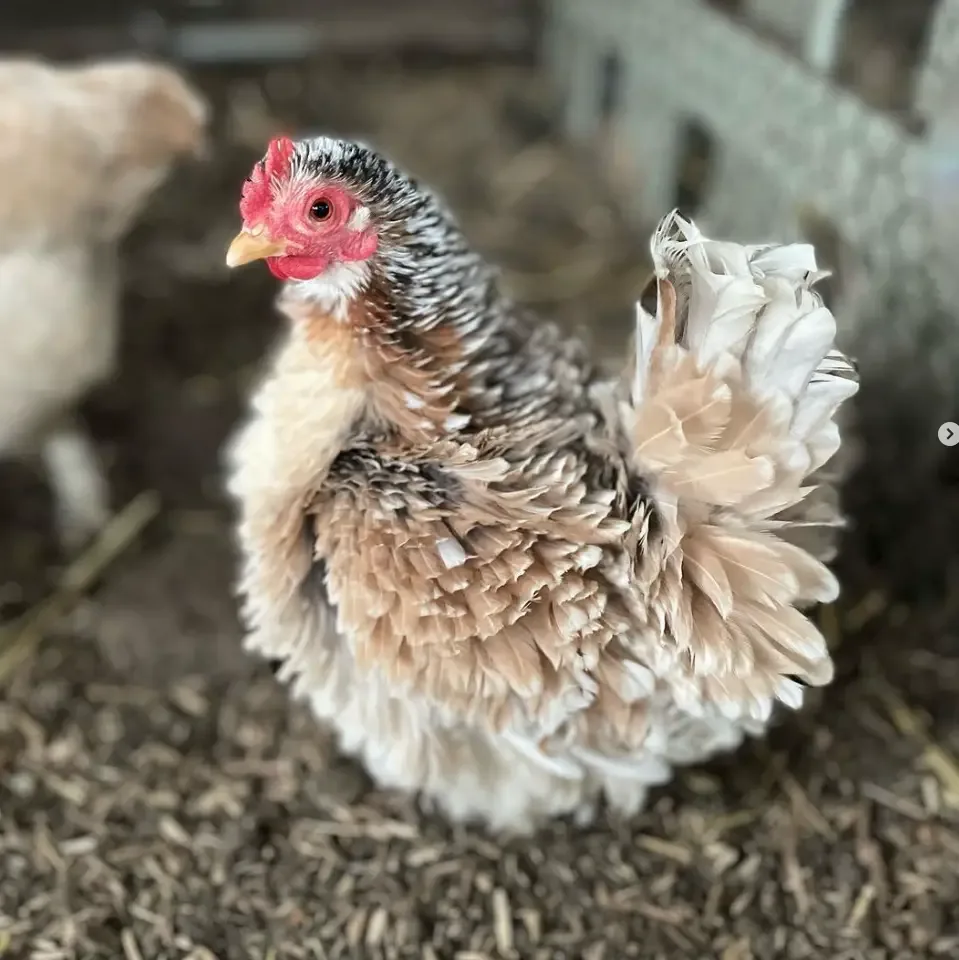
Frizzle Chicken Overview
| Lifespan | 6 – 8 years |
| Weight | Hen: 5 – 6 lbs, Rooster: 7 – 8 lbs |
| Appearance | Varies, but feathers are curved outwards and fluffy |
| Egg Color | Cream or brown |
| Egg Size | Small to medium |
| Egg Production | 100 – 200 eggs per year (2 – 4 per week) |
| Broodiness Level | Medium (it varies based on the chicken breed) |
| Beginner Friendly | Yes |
| Space Needed | 4 square feet inside the coop, 16 square feet outside the coop |
| Price | $3 – $8 per chick |
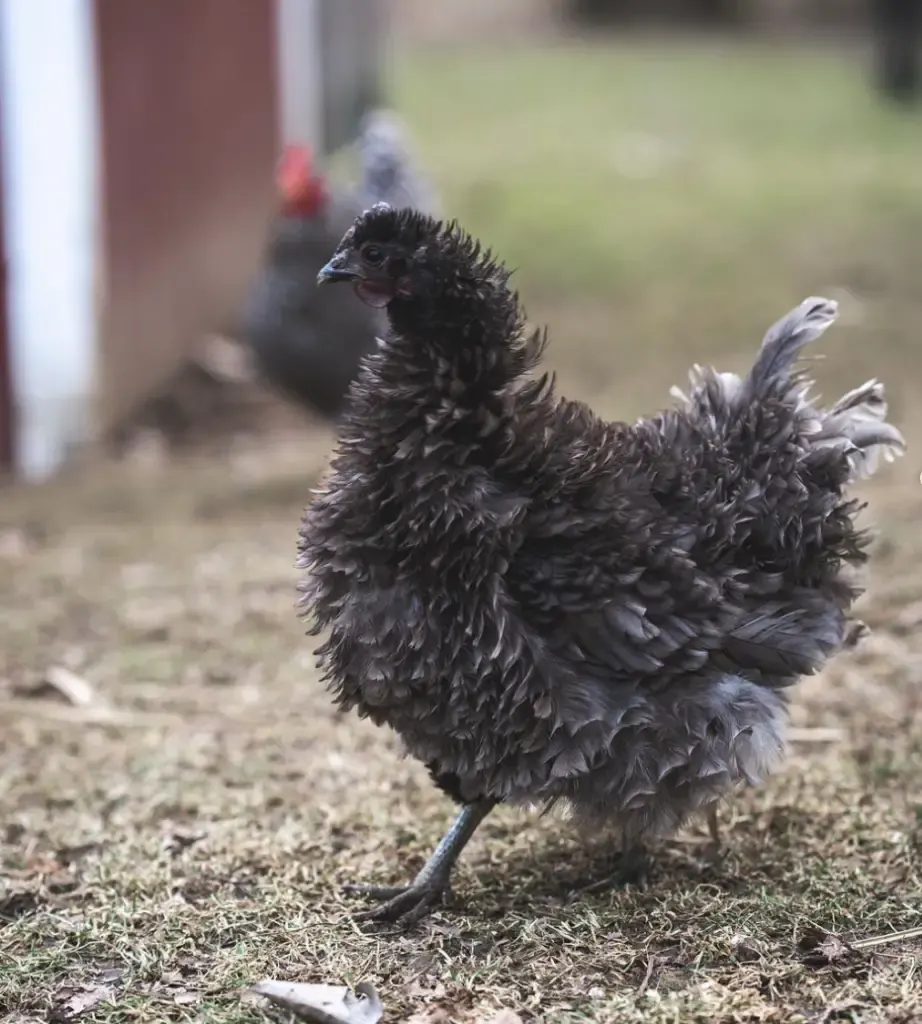
Frizzle Breed Standards
There are 10 different countries that consider Frizzle chickens to be an actual breed, however, the United States does not.
The frizzle gene can appear in various breeds of chickens, which is why they are not classified as an actual breed in the US.
However, you can still showcase a Frizzle chicken in the United States under its actual breed name (Cochin, Polish, etc).
They would then be judged according to the standard of that particular breed.
Additionally, breeding two Frizzles together is not recommended, as there is a 25% chance that you will end up with a Frazzle.
A Frazzle chicken has two copies of the incomplete dominant gene (F).
Frazzles can be significantly more fragile and can also end up with health problems like heart issues or feather loss.
Their feathers are typically delicate and can break off with the simplest touch. They also don’t live very long.
Unfortunately, it is difficult to know what feather type a Frizzle is until they start to grow out their feathers.
Breeding Frizzle Chickens
As stated above, breeding Frizzles can be simple if done correctly.
Here is a breeding chart for Frizzle chickens:
| Normal feathers x Frizzle Feathers | 50% chance of normal feathers, 50% chance of frizzle feathers |
| Frizzle feathers x Frizzle feathers | 25% chance of normal feathers, 50% chance of frizzle feathers, 25% frazzle feathers |
Based on the chart, it is best to breed a chicken with normal feathers and one with frizzle feathers to avoid potentially breeding a Frazzle chicken.
Frazzle chickens tend to have a lot of health issues and typically won’t live as long as Frizzle chickens.
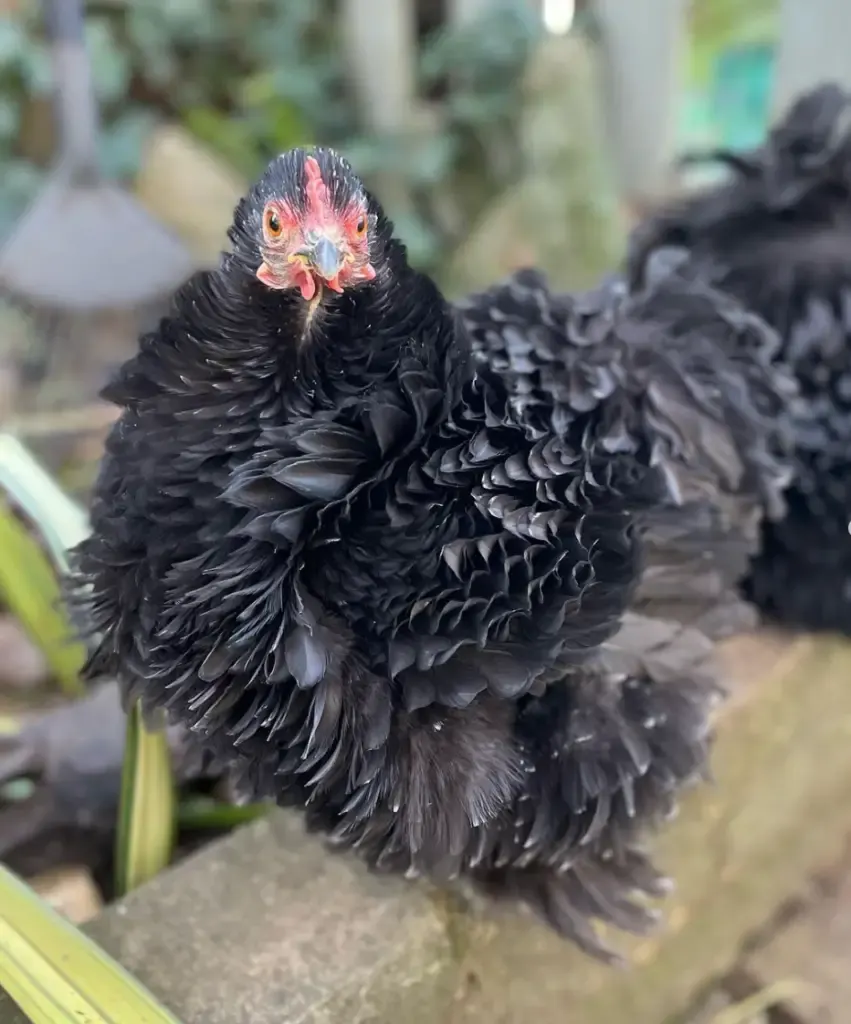
Appearance
In the United States, Frizzle chickens have the appearance of whatever breed of chicken they are.
For instance, a frizzled Cochin will take on the colors and structure of a Cochin chicken, just with frizzled feathers.
In general, Frizzle chickens appear to be fluffed out, with their feathers curling outwards instead of laying flat along their bodies.
Although Frizzle chickens are not accepted as a breed in the United States, they are in other countries such as Austria, Belgium, Czech Republic, France, Germany, Ireland, Italy, Poland, Slovakia, and the United Kingdom.
Frizzle chickens have a single red comb and their beak color will depend on the color of their feathers (darker feathers mean a darker beak color).
They typically have long wings and an upright tail.
The rest of their coloration strongly depends on the breed of chicken they are.
Size and Weight
The size and weight of Frizzle chickens depend on what breed they are.
In general, you can expect a standard Frizzle hen to weigh between 5 and 6 pounds and Frizzle roosters to weigh between 7 and 8 pounds.
Color Varieties
Frizzle chickens come in an array of colors and patterns, making them visually appealing additions to any flock.
Their coloring will depend on which breed of chicken they are.
In this case, you can typically find Frizzles in:
- Buff
- Black
- Brown
- White
- Cuckoo
Their vibrant plumage, coupled with their unique feather structure, makes them an eye-catching presence in any backyard or farm.

Egg Production
Frizzle chickens are not just a pretty face; they also produce eggs and can be raised for meat.
While frizzles are not known for being prolific egg layers, their eggs are still a valuable addition to your kitchen counter.
Depending on which breed you have, you can expect Frizzles to lay between 2 – 4 small to medium eggs per week or 100 – 200 eggs per year.
They also have a good chance of becoming broody and are good mothers when they are allowed to sit on their eggs.
Frizzle Chicken Personality & Temperament
Aside from their stunning appearance, frizzle chickens are known for their friendly and docile nature.
Their personalities and temperaments strongly depend on what breed they are, however, they are generally very friendly, making them great companions for both adults and children alike.
Frizzles are also relatively low-maintenance, requiring the same care and attention as other chicken breeds.
Because they are so docile and sweet, it is important to house Frizzles with similar breeds such as Silkies, Cochins, Plymouth Rocks, etc.
This way, the Frizzles will not become bullied by chicken breeds with stronger personalities.
Noise Levels
Frizzle chickens are not commonly chatty or loud.
They are typically even more docile and quiet than their standard breed counterparts.
However, they tend to be more social around their owners and may be slightly more chatty once they get to know you.
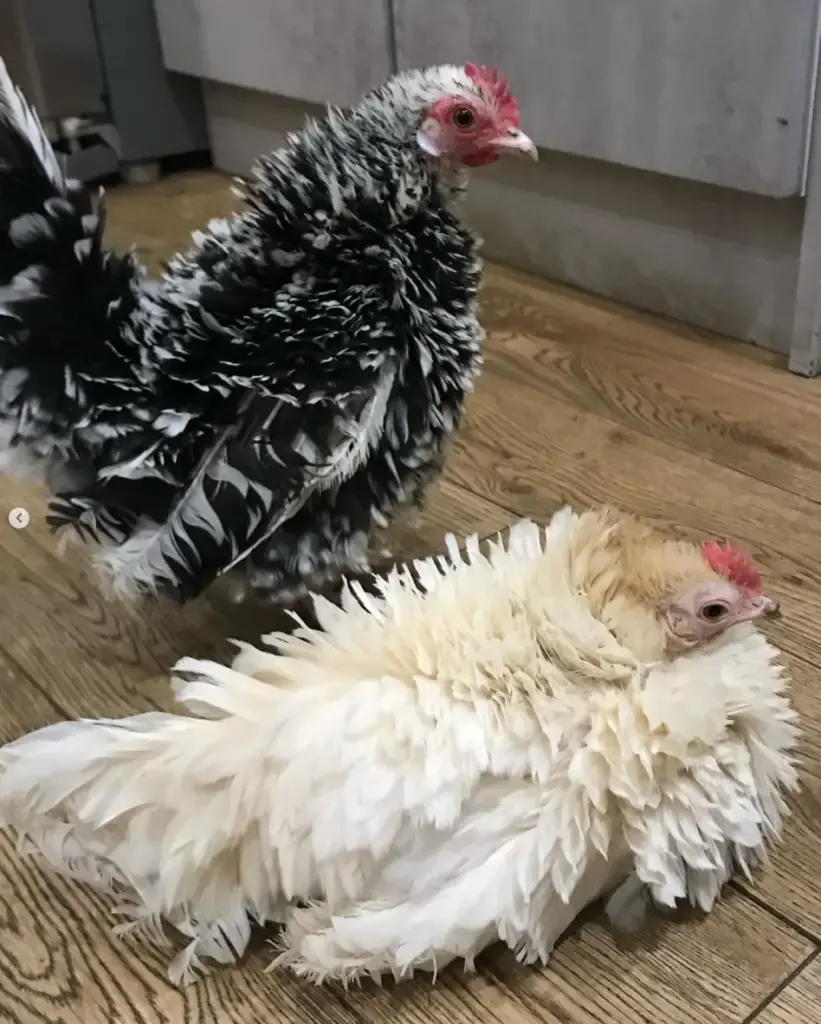
Frizzle Chicken Care
Just like with other chickens, Frizzles need proper care in order to thrive.
Providing them with a safe, spacious coop, a balanced diet, and regular health check-ups will ensure their well-being.
Here are some tips on how to best care for Frizzle chickens:
Feeding
Most chicken breeds require a balanced diet of high-quality commercial feed, some treats and snacks, and access to clean, fresh water.
For most of the year, a 16% layer feed is adequate, however, during their molt, Frizzles require an increase of protein of 18%-20% to help them replace their feathers.
It is also important to supplement with some treats such as fruits, vegetables, high-calcium snacks, and high-protein sources like mealworms or black fly larvae.
Adding extra protein and calcium to their diet will ensure that they continue to lay strong, healthy eggs.
Keep in mind that their diet should consist of mostly high-quality commercial feed with only 10%-20% of their diet being snacks, treats, or table scraps.
Coop Setup
Frizzle chickens do best when given adequate space both inside their coop and outside in the run (or free-ranging).
Each Frizzle chicken requires 4 square feet of space inside their coop.
They will also each need about 8-10 inches of roosting space.
Their perches and nesting boxes should be close to the ground or have ladder access Frizzle chickens can not fly and one nesting box per 4-5 hens is best.
If you plan to have your Frizzles outside in a run during the day, each chicken will need about 16 square feet of space per bird.
It’s important that their coop is covered and properly secured in order to protect them from predators and severe elements like rain and wind. These birds need to stay warm and dry.
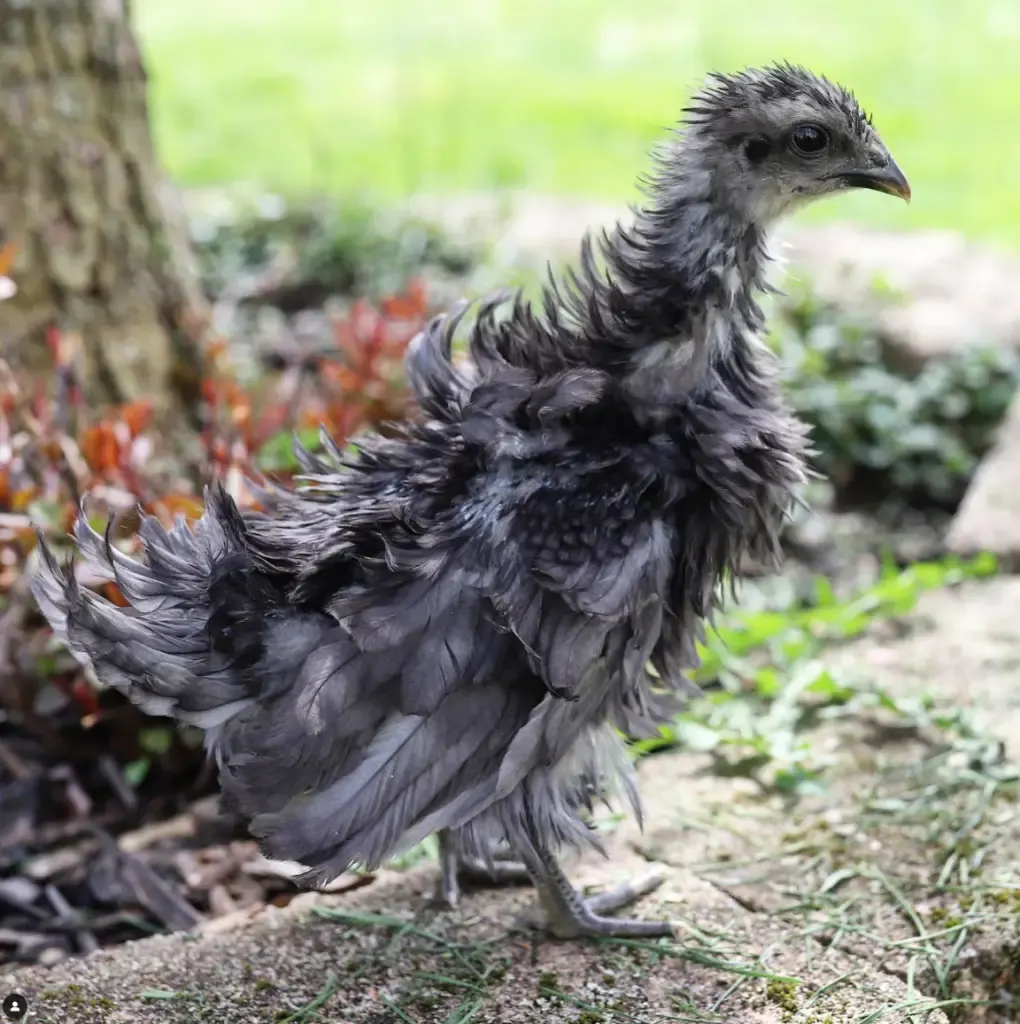
Free Ranging
Frizzle chickens also enjoy free ranging and roaming when given the chance.
Outside of the coop, Frizzles require about 16 square feet of space per bird.
Foraging outside of their coop will also provide them with added nutrients from the grass, bugs, and other food sources.
Health Issues
Frizzle chickens are typically pretty hardy and are not prone to common health issues in poultry.
However, all chicken breeds have the chance of suffering from the occasional parasite.
It is important to provide regular checkups to look for lice and mites, bumblefoot, intestinal parasites, and egg binding or prolapse.
Failure to catch and treat any of these health problems promptly can result in long-term health issues or even death.
Additionally, because Frizzle feathers do not lay flat on their bodies, they can suffer in wet or overly cold weather. If one of your Frizzles gets wet from water or snow, they need to be dried and warmed up immediately to avoid hypothermia or frostbite.
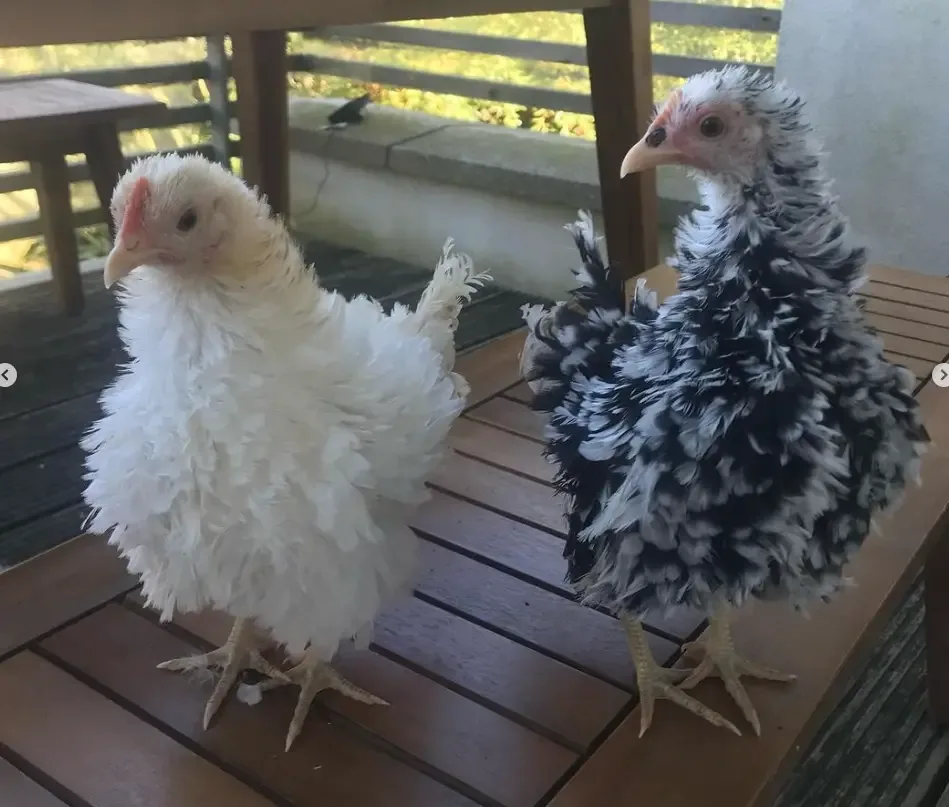
Showcasing Your Frizzle Chickens
Frizzle chickens were introduced to Europe in the 1700s and quickly became popular as exhibition birds. They were prized for their unique appearance and were often exhibited at poultry shows.
For chicken enthusiasts who appreciate the competitive side of poultry keeping, frizzle chickens can be exhibited in poultry shows.
Show-quality frizzles are judged based on their overall appearance, feather quality, and conformity to breed standards.
Participating in poultry shows can be a rewarding experience, allowing you to showcase the beauty of your frizzle flock.
Final Thoughts
Frizzle chickens are undeniably captivating creatures that bring a touch of whimsy to any flock.
With their curly feathers, friendly personalities, and a wide range of colors and patterns, they have become a favorite among any backyard chicken keeper.
Whether you’re looking to add a unique breed to your backyard or simply admire these feathered wonders, frizzle chickens are sure to delight and entertain both young and old.
So why not consider adding these feathered curiosities to your flock?
Still unsure? Keep reading below for some frequently asked questions.
FAQs
What 2 breeds make a Frizzle chicken?
Frizzle chickens are not a breed in themselves, but rather a feather variant of other chicken breeds.
The frizzle part of their name comes from the feathers curling out instead of laying flat along their bodies.
What chickens can be Frizzle?
The most common breeds of Frizzle chicken include Cochins, Polish, Barred Rocks, Japanese Bantams, Silkies, and Orpingtons.
Do Frizzle chickens lay eggs?
While they are not known for their egg-laying abilities, Frizzle chickens can lay anywhere between 2 and 4 eggs per week.
Are Silkies and Frizzles the same?
No, Silkie chickens and Frizzle chickens are not the same, although Silkie chickens can be frizzled.
A Silkie chicken with the frizzle gene is called a Sizzle.

